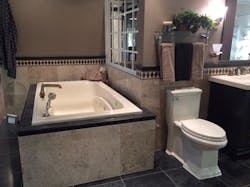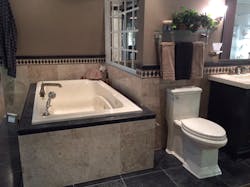Kitchen, bath trends: how they impact contractors' businesses
As a plumbing contractor, it’s very easy to take an “if it’s not broke, don’t fix it” attitude toward the latest kitchen and bath trends. Humans are creatures of habit; once we learn to do something a certain way that works, it’s often hard to break out of that comfort zone.
Consumer tastes, as well as updated codes and standards, are constantly evolving, requiring the plumbing professional to stay current in order to maintain a thriving business.
New, more complex plumbing products and technologies — highlighting accessibility, water efficiency, digital operation, and contemporary home decor trends — are proliferating and gaining wider acceptance. Understanding these products will be crucial to answering customer questions and meeting consumer demand.
From a business standpoint, recognizing these four major trends is important to ongoing growth as a plumbing contractor:
1. Universal Design: Universal design is conventionally understood as making living spaces amenable to special-needs populations, including the elderly and those with limited mobility. Unfortunately, these products often had an unattractive and impersonal look.
Not so today. Recent years have brought universally designed plumbing faucets and fixtures that are practical and desirable for everyone, without the institutional design that plagued earlier models.
American Standard CEO to lead Global Sanitation Session at Clinton Global Initiative Annual Meeting
Stylish lever handle faucets. Aesthetically pleasing grab bars that easily blend into bath décor. Walk-in bathtubs with safe, comfortable seating and extra-fast water drains. Chair-height toilets enjoyed by all ages. Hot limit safety stops on single-control faucets to prevent scalding. These are examples of products that accommodate the needs and safety of multi-generational households, while offering contemporary design options for homeowners.
No longer is there a need to compromise design in exchange for functionality. Today's consumers — particularly the rapidly aging Baby Boomer generation — will increasingly become open to incorporating Universal Design in their kitchens and bathrooms. A firm knowledge of these products, their unique characteristics and their proper installation will be indispensable for the plumbing contractor.
2. Improved efficiency, performance: Over the past year, half the United States has experienced some level of drought conditions, forcing plumbing code officials to explore additional avenues for using available water supplies more efficiently. Consumers are becoming more aware of shopping for the WaterSense label from the U.S. Environmental Protection Agency. The WaterSense label certifies that bath faucets and toilets provide high performance while using at least 20 percent less water than conventional products.
High-efficiency toilets (HETs) that “use less to accomplish more” — only 1.28 gallons per flush (gpf) — have the dual benefit of water conservation and superior performance. Many HETs achieve the highest bulk removal score on the Maximum Performance (MaP) test, an independent report of toilet performance. These high achiever toilets can successfully flush 1,000 grams (2.2 pounds) of waste on just 1.28 gpf. Plumbing contractors will especially appreciate this optimum flushability, which translates into fewer clogs and fewer call-backs.
Water saving showerheads are engineered to produce powerful, invigorating water stream patterns while using up to 40 percent less water than conventional models. WaterSense-certified bathroom faucets, available in a breadth of stylish forms, can provide a generous water flow while using only 1.5 gpf.
Given greater awareness of water issues in many communities, plumbing contractors are on the front lines of assuring homeowners that less water doesn’t compromise performance. In turn, these plumbers will win sales among consumers who are actively seeking ways to reduce their overall water usage or who put a premium on being socially responsible citizens.
3. Digital technologies: The digital age has had a profound impact on all aspects of life, including plumbing. Contractors are already well versed in handling the electronics involved with digital controls and similar type installations. But as consumers are increasingly incorporating complex electronic equipment into their kitchens and baths, the responsive plumber will need to be aware of the changing, more sophisticated technologies on the market.
In the luxury market, the simple commode is being replaced with electronic units incorporating cleansing, drying and other comfort features, all controlled with the touch of a button. Basic steam showers have morphed into sophisticated spa systems employing lights, music and aromatherapy. Residential bathroom and kitchen faucets are now available in hands-free varieties, with even more advanced electronic features on the horizon.
The astute plumbing contractor will keep up with these changing technologies, making sure to stay ahead of the curve regarding training and installation techniques, to become the customers' go-to resource for the growing digital plumbing marketplace.
4. Shift to contemporary looks: Understanding new trends in kitchen and bath design is important so that plumbers can hold relevant conversations with their customers. As the economy recovers, American design preferences are shifting from traditional styles to a cleaner, softer and more contemporary look.
Visiting a local supply house and touring its showroom display is a great way to see what's new. Showroom consultants study industry trends as a matter of course and will be able to advise on the best ways to address changing consumer demand.
Take charge of your continuing education. Read home design blogs to learn what is trending. Subscribe to newsletters from leading plumbing manufacturers. Join trade associations that are a source of industry and style information via webinars, workshops and whitepapers. Specifically, the National Kitchen & Bath Association (NKBA) tracks kitchen and bath product and design trends annually.
Embrace these latest trends. Learn as much as possible about what is new. Incorporate this current information into your plumbing toolbox of knowledge in order to meet the changing needs of your customer.
Jean-Jacques L’Hénaff is vice president, design, for American Standard Brands. L'Henaff had served as an executive at firms in the industrial design, plumbing and digital technology fields prior to joining American Standard. He holds a B.S. in product and transportation design from Ecole Superieure de Design Industriel in Paris.

